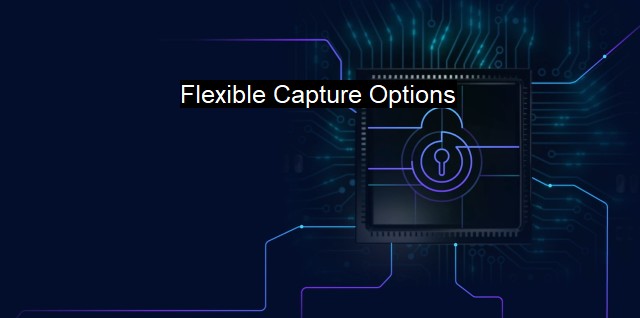What are Flexible Capture Options?
Why Flexible Capture Options are Crucial for Modern Cybersecurity and Antivirus Technology: Improving Threat Detection and Response in Real-Time
Flexible Capture Options is an in-depth topic to explore within the context of cybersecurity and antivirus measures. Understanding Flexible Capture Options requires knowledge on intrusion detection, incidence responses, and general data protection technologies that all play a pivotal role in cybersecurity.A core aspect in strengthening security posture is the ability to effectively capture, analyze and appropriately respond to potential threats. Capture options, in this context, refer to the different techniques and strategies employed in gathering threat or system data – ranging from network traffic, system logs, application activity to user behaviors. The more adaptable or ‘flexible’ these options are, the better they can address the fast-evolving threat landscape.
Flexibility becomes an essential trait given the myriad forms cyber threats can adopt. For instance, a basic network packet capture like TCP Dump could be an effective option in diagnosing network problems, while potent solutions like Security Information and Event Management (SIEM) and Network Traffic Analysis (NTA) systems stand better chances at detecting more sophisticated threats. Ideally, a network should combine multiple, frequently updated capture options to avoid blind spots that a cybercriminal could exploit.
Utilising flexible capture options enables the organization to design a customized security architecture pertinent to its own needs and unique threat landscape. They can pick among in-house solutions or third-party services, open-source or proprietary platforms, standalone or integrated systems, and much more. Some capture options focus on known malware/threat signatures while others apply machine learning for anomaly-based threat detection, making them effective against ‘zero-day’ threats.
One of the use-cases of these options includes the antivirus systems which often come with various data capture options. Some continually monitor file system activities to detect any abnormal or suspicious behavior (dynamic analysis), often known as real-time or on-access scanning. Others focus more on manual, scheduled or upon-request scanning (static analysis) with a non-intrusive approach. Certain more advanced antiviruses also leverage cloud-based capture, AI algorithms, and other more flexible capture options to ensure enhanced security against the evolving threats.
Flexible Capture Options have also elicited substantial benefits in responding to security incidents due to their large and varied data pools. Cybersecurity teams can flexibly retrieve and utilize captured data to investigate and remediate security events. For instance, historical network traffic data could be valuable in cracking the case of a persistent threat lurking within the network. orchestrated responses to newly discovered threats could be executed by instructing the capture options what new data to acquire or what type of behavior they should be observing and flagging.
In capturing operation, the application of flexible options is not strictly limited to the threat detection and response, but also towards ensuring performance and reliability of IT systems – a crucial yet often overlooked aspect in a comprehensive security approach. Network administrators don’t just collect data about potential attacks but can also use the data gathered by these flexible capture options for identifying system inefficiencies or glitches that could impact system’s reliability or sometimes even opening up vulnerabilities.
Flexible capture options are indispensable tools in today's dynamic cyber threat environment. They work as proactive detective measures employed by both cybersecurity professionals and antivirus systems to collect, analyze, and counter potential cyber-attacks of all kinds – maintaining data integrity, privacy, and bolstering the overall cybersecurity frameworks. Fundamentally, they offer the ability to adapt, evolve, and stay a few steps ahead of the adversary. Flexible capture options are not just a technical component, but more of a strategic cornerstone in the journey towards a more secure cyber world.

Flexible Capture Options FAQs
What are flexible capture options in the context of cybersecurity and antivirus?
Flexible capture options refer to the ability of an antivirus software to capture and analyze various types of data from different sources, such as emails, files, network packets, and memory processes. These options help in detecting and preventing different types of cyber threats, including malware, viruses, and spyware.What are the benefits of using flexible capture options in an antivirus software?
Flexible capture options provide several benefits, such as increased detection and prevention rates for known and unknown cyber threats, faster response time to new threats, better visibility into network traffic and behavior, and enhanced security posture for the organization.What types of data can be captured using flexible capture options in an antivirus software?
Flexible capture options allow capturing and analyzing different types of data, such as file-based data (executable files, documents, compressed files), network packet data (TCP/IP packets, HTTP traffic, DNS queries), memory-based data (processes, threads, modules), and email-based data (SMTP traffic, POP3 traffic).How can I enable flexible capture options in my antivirus software?
Enabling flexible capture options will depend on the specific antivirus software you are using. Most antivirus software will have options to configure or enable features such as network scanning, email scanning, real-time monitoring, and memory scanning. You can consult the user manual or the vendor's website for instructions on how to enable these options.| | A | | | B | | | C | | | D | | | E | | | F | | | G | | | H | | | I | | | J | | | K | | | L | | | M | |
| | N | | | O | | | P | | | Q | | | R | | | S | | | T | | | U | | | V | | | W | | | X | | | Y | | | Z | |
| | 1 | | | 2 | | | 3 | | | 4 | | | 7 | | | 8 | | |||||||